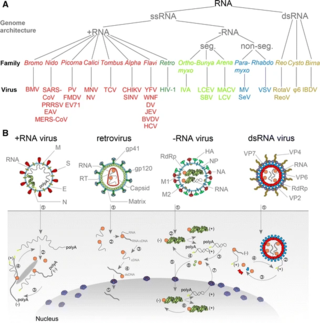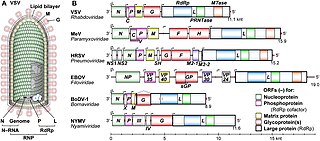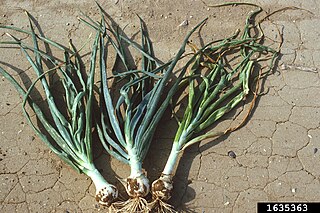
An RNA virus is a virus—other than a retrovirus—that has ribonucleic acid (RNA) as its genetic material. The nucleic acid is usually single-stranded RNA (ssRNA) but it may be double-stranded (dsRNA). Notable human diseases caused by RNA viruses include the common cold, influenza, SARS, MERS, Covid-19, Dengue Virus, hepatitis C, hepatitis E, West Nile fever, Ebola virus disease, rabies, polio, mumps, and measles.
Virus classification is the process of naming viruses and placing them into a taxonomic system similar to the classification systems used for cellular organisms.

Mononegavirales is an order of negative-strand RNA viruses which have nonsegmented genomes. Some common members of the order are Ebola virus, human respiratory syncytial virus, measles virus, mumps virus, Nipah virus, and rabies virus. All of these viruses cause significant disease in humans. Many other important pathogens of nonhuman animals and plants are also in the group. The order includes eleven virus families: Artoviridae, Bornaviridae, Filoviridae, Lispiviridae, Mymonaviridae, Nyamiviridae, Paramyxoviridae, Pneumoviridae, Rhabdoviridae, Sunviridae, and Xinmoviridae.

The genus Marburgvirus is the taxonomic home of Marburg marburgvirus, whose members are the two known marburgviruses, Marburg virus (MARV) and Ravn virus (RAVV). Both viruses cause Marburg virus disease in humans and nonhuman primates, a form of viral hemorrhagic fever. Both are Select agents, World Health Organization Risk Group 4 Pathogens, National Institutes of Health/National Institute of Allergy and Infectious Diseases Category A Priority Pathogens, Centers for Disease Control and Prevention Category A Bioterrorism Agents, and are listed as Biological Agents for Export Control by the Australia Group.

Tobamovirus is a genus of positive-strand RNA viruses in the family Virgaviridae. Many plants, including tobacco, potato, tomato, and squash, serve as natural hosts. Diseases associated with this genus include: necrotic lesions on leaves. The name Tobamovirus comes from the host and symptoms of the first virus discovered.
DPVweb is a database for virologists working on plant viruses combining taxonomic, bioinformatic and symptom data.
American hop latent virus (AHLV) is a plant pathogenic virus of the family Betaflexiviridae. Its genome is about 8,600 nucleotides in length with a 3'-polyadenylate tail that contains a total of six open reading frames.

Potexvirus is a genus of pathogenic viruses in the order Tymovirales, in the family Alphaflexiviridae. Plants serve as natural hosts. There are 48 species in this genus, three of which are assigned to a subgenus. Diseases associated with this genus include: mosaic and ringspot symptoms. The genus name comes from POTato virus X).

Carlavirus, formerly known as the "Carnation latent virus group", is a genus of viruses in the order Tymovirales, in the family Betaflexiviridae. Plants serve as natural hosts. There are 53 species in this genus. Diseases associated with this genus include: mosaic and ringspot symptoms.

Marseilleviridae is a family of viruses first named in 2012. The genomes of these viruses are double-stranded DNA. Amoeba are often hosts, but there is evidence that they are found in humans as well. The family contains one genus and four species, two of which are unassigned to a genus. It is a member of the nucleocytoplasmic large DNA viruses clade.
Daphne virus S (DVS) is a plant virus that infects daphnes. Infection causes leaf distortion and chlorotic spot disease symptoms. Its genome is about 8,700 nucleotides in length and contains six open reading frames that encode for a viral replicase, a triple gene block and capsid proteins.
Yingchengvirus is a genus of double stranded DNA viruses that infect haloarchaea. The genus was previously named Betasphaerolipovirus.
Narcissus common latent virus (NCLV) is a plant pathogenic virus. It infects Narcissus plants. The term 'latent' refers to the fact that infection may be symptomless. Transmission occurs by Aphids.
Narcissus degeneration virus (NDV) is a plant pathogenic Potyvirus of the family Potyviridae which infects plants of the genus Narcissus. It is one of the most serious and prevalent of the approximately 21 viruses which infect this genus.NDV is associated with chlorotic leaf striping in N. tazetta.
Amalgaviridae is a family of double-stranded RNA viruses. Member viruses infect plants and are transmitted vertically via seeds. The name derives from amalgam which refers to amalgaviruses possessing characteristics of both partitiviruses and totiviruses. There are ten species in the family.
Lolavirus is a genus of viruses in the order Tymovirales, in the family Alphaflexiviridae. Plants, specifically ryegrass, serve as natural hosts. There is only one species in this genus: Lolium latent virus.

Genomoviridae is a family of single stranded DNA viruses that mainly infect fungi. The genomes of this family are small. The genomes are circular single-stranded DNA and encode rolling-circle replication initiation proteins (Rep) and unique capsid proteins. In Rep-based phylogenies, genomoviruses form a sister clade to plant viruses of the family Geminiviridae. Ten genera are recognized in this family.

Onion yellow dwarf virus (OYDV) is a plant virus in the genus Potyvirus that has been identified worldwide and mainly infects species of Allium such as onion, garlic, and leek. The virus causes mild to severe leaf malformation, and bulb reduction up to sixty percent has been observed in garlic.
Garlic common latent virus (GarCLV) is a plant virus member of the genus Carlavirus that has been found infecting garlic globally. Detection of the virus in leek and onion has also been reported.
Shallot latent virus (SLV), a species of Carlavirus, was first identified in shallots in Netherlands. The virus particle is elongated, 650 nm in length.








